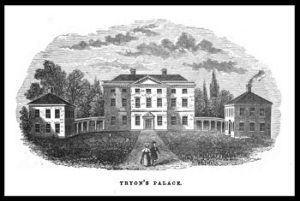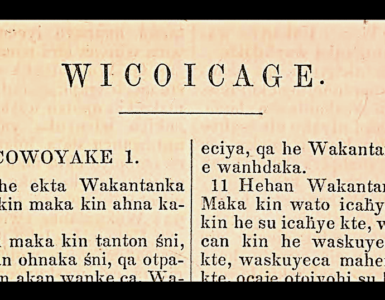 John was born in 1791 at Pembroke across the Trent River from Tryon Palace in New Bern, North Carolina, to David and Mary (Jones) Witherspoon. The infant’s parents and their ancestors may constitute a genealogy for the record books in terms of their importance for their eras. His mother was a descendant of Frederick Jones who was chief justice of the colony of North Carolina from 1717 to 1721, and she was the widow of Continental Congress representative and North Carolina Governor Abner Nash. John’s father was the son of the Presbyterian Scot, Rev. John Witherspoon of the College of New Jersey who was a founding father and signer of the Declaration of Independence. David decided not to enter the ministry like his father but instead read law and became a member of the bar in New Bern. One of John’s aunts, Frances Witherspoon, was the wife of historian David Ramsay whose History of South Carolina, 1670-1808, continues to be an important source for the early history of the Palmetto State. Another aunt, Anna Witherspoon, was the wife of Samuel Stanhope Smith. Smith succeeded Anna’s father, John Witherspoon, in the president’s office of the College of New Jersey. Anna was also the grandmother of John C. Breckinridge who worked in both houses of the United States Congress, was Vice President of the United States during the Buchanan administration, and served the Confederacy both in the army and as secretary of war. John had an august body of ancestors with still others that could be mentioned.
John was born in 1791 at Pembroke across the Trent River from Tryon Palace in New Bern, North Carolina, to David and Mary (Jones) Witherspoon. The infant’s parents and their ancestors may constitute a genealogy for the record books in terms of their importance for their eras. His mother was a descendant of Frederick Jones who was chief justice of the colony of North Carolina from 1717 to 1721, and she was the widow of Continental Congress representative and North Carolina Governor Abner Nash. John’s father was the son of the Presbyterian Scot, Rev. John Witherspoon of the College of New Jersey who was a founding father and signer of the Declaration of Independence. David decided not to enter the ministry like his father but instead read law and became a member of the bar in New Bern. One of John’s aunts, Frances Witherspoon, was the wife of historian David Ramsay whose History of South Carolina, 1670-1808, continues to be an important source for the early history of the Palmetto State. Another aunt, Anna Witherspoon, was the wife of Samuel Stanhope Smith. Smith succeeded Anna’s father, John Witherspoon, in the president’s office of the College of New Jersey. Anna was also the grandmother of John C. Breckinridge who worked in both houses of the United States Congress, was Vice President of the United States during the Buchanan administration, and served the Confederacy both in the army and as secretary of war. John had an august body of ancestors with still others that could be mentioned.
When he was about eight years old, John’s mother passed away and his father moved the family to Princeton, New Jersey. Shortly after settling in their home, his father died, so as his will stipulated, John was placed under the co-guardianship of President Smith of the College of New Jersey and John C. Osborne, M.D., back in New Bern. Guardian Smith provided the opportunity for a good education for John by sending him to the academy operated by pastor of the Presbyterian Church in Baskingridge, New Jersey, Robert Finley, but because of John’s poor behavior he was discharged from the school and sent to New Bern to continue studies under the oversight of Dr. Osborne. For additional preparation he studied in Chapel Hill with Rev. Abner Clopton before entering the University of North Carolina and graduating with two classmates in 1810 with a Bachelor of Arts. The Presbyterian minister, Joseph Caldwell, was president of the university at the time. John Witherspoon then worked in the office of Chief Justice of North Carolina Frederick Nash where in due time he was admitted to the bar. On July 1, 1813, John and Susan D. Kollock were married by her brother-in-law, John McDowell, the pastor of the Presbyterian Church in Elizabethtown, New Jersey. Susan was the daughter of Shepard Kollock and sister of Rev. Henry Kollock of Savannah and Shepard K. Kollock and other siblings. Her brother Shepard was Professor of Logic and Rhetoric in the University of North Carolina, 1819 to 1825. With his education, legal experience, and new bride, John was ready for his career at the bar, but his plans for the legal profession would be changed.
On one occasion while visiting Philadelphia, John Witherspoon attended worship on the Lord’s Day in Second Presbyterian Church where he heard a sermon by Pastor Thomas Skinner that started him thinking about the gospel. When he returned home, he attended services in the Presbyterian Church at Chapel Hill where worship was led by President Robert Chapman of the University of North Carolina. John came to profess faith in Christ under Chapman’s ministry. He then decided to abandon the practice of law and devote himself to the Gospel ministry.
To prepare himself theologically for ministry, he turned to his brother-in-law, John McDowell. The Witherspoons moved back to Elizabethtown and John studied theology with McDowell’s guidance. In the Spring of 1816, he was licensed by the Presbytery of Jersey and then moved his household to Hillsborough, North Carolina. The village did not have a church, so Witherspoon was a missionary tasked with gathering a congregation which in a matter of months was organized by Orange Presbytery into a church on September 25, 1816 with Witherspoon ordained the following year.
The young pastor was soon involved in service in his presbytery and higher judicatories. In 1817, following his installation in Hillsborough, he was a commissioner to the General Assembly convened in Philadelphia. The next year he became the Stated Clerk of Orange Presbytery and continued till the fall of 1827. Whether or not the burning of presbytery records by the fire that consumed his home on January 1 of that year contributed to his decision to resign is not stated. He participated in the dedication of the church building of First Church, Raleigh, with William McPheeters on February 7, 1818. He also assisted in the organization of the First Presbyterian Church of Greensboro. In 1836, John received an honor that his like-named grandfather was unable to experience in full—he was elected moderator of the General Assembly of the PCUSA. The following year when he delivered his retiring moderator’s sermon in Central Presbyterian Church, Philadelphia, his passage was 1 Corinthians 1:10, 11.
Now I beseech you, brethren, by the name of our Lord Jesus Christ, that ye all speak the same thing, and that there be no divisions among you; but that ye be perfectly joined together in the same mind, and in the same judgment. For it hath been declared to me of you, my brethren, by them which are of the house of Chloe, that there are contentions among you.
His choice of passage reflects his experience during the 1836 Assembly when deliberations showed division in the body that would lead to separation of the PCUSA into Old and New Schools during the 1837 meeting. Even though John Witherspoon is not as well known today as his grandfather, he was an important minister and churchman in his era.
Pastor Witherspoon had been in Hillsborough about sixteen years when in 1832 Bethesda Presbyterian Church in Camden, South Carolina, expressed interest in calling him to be their minister. For ten years the well-established congregation had been meeting in its church designed by Washington Monument architect and Charleston born Robert Mills. It was a good opportunity for Witherspoon, so he accepted the call and was transferred to Harmony Presbytery in 1833. It was only about four years before he was offered a call to First Church, Columbia. The Camden congregation urged him to decline and protested his move at a meeting of Harmony Presbytery, but his call was dissolved allowing him to move to Columbia. However, his stay in Columbia was a brief one because he returned to Hillsborough in North Carolina after a few years because of health problems.
John Witherspoon’s last days were spent in Hillsborough. His health continued to decline but he did not cease ministry. Despite physical limitations he participated in preaching and other church work as he could. On the thirty-seventh anniversary of his installation in the Hillsborough Church, September 25, 1853, he passed away after a severe illness. He was survived by Susan, who would die just six months later on March 31, 1854. Of their seven children—Frederick Nash, Susan Kollock, John Knox, Henry Kollock, David Brainard, George Burgwin, and Mary Nash—Frederick and George predeceased them both.
Witherspoon was respected and honored by his peers. He was given the Master of Arts by the University of North Carolina, 1813, where he was a trustee, 1817-1834; the Doctor of Divinity was conferred by Lafayette College, 1836; and the Doctor of Laws was given by the University of North Carolina. However, in his later years he was the subject of controversy regarding personal issues, but after investigation by a committee appointed by Orange Presbytery, no action was taken against him (Stone, 262-63).
Barry Waugh
Notes—The building in the image above is Tryon Palace, which was the first permanent state capitol of North Carolina. Robert H. Stone’s book, A History of Orange Presbytery, 1970, is a fine judicatory history with considerable information about Witherspoon, and it provides lists of ordinations, churches, and presents brief pieces about cases before presbytery. A picture of his grave inscription is available on Find a Grave, but I believe the identification of him as “John Knox Witherspoon, Sr.” is not correct. Some sources call this John Witherspoon “John Knox Witherspoon,” but Knox is not on his grave marker and other sources say nothing about the Knox middle name; I have chosen not to use the middle name based on its omission from the grave marker. He is buried in the cemetery of the Presbyterian Church in Hillsborough, and if a minister had the middle name of Knox it seems to me his children would include it given John Knox’s significance for Presbyterianism (surely a subjective reason). The names of the Witherspoon children are from Joseph R. Klett’s Genealogies of New Jersey Families, 1996. Biographical information was located in Biographical History of North Carolina From Colonial Times to Present, S. A. Ashe, ed., vol. 5, Greensboro: Charles L. Van Noppen, 1906; the article by Frederick Nash titled, “Rev. John Witherspoon, D.D., LL.D.,” from North Carolina University Magazine 7 (April 1888): 137-143. Information about Witherspoon’s time in First Church, Columbia, is from David B. Calhoun’s history of the church, The Glory of the Lord Risen Upon It. Some sources say Witherspoon received both an A.M. and D.D. from the College of New Jersey, but I could find no mention of them in Princeton University General Catalogue 1746-1906; it may be that somehow he was confused with his grandfather or another one of the men named John Witherspoon mentioned in the catalog.





